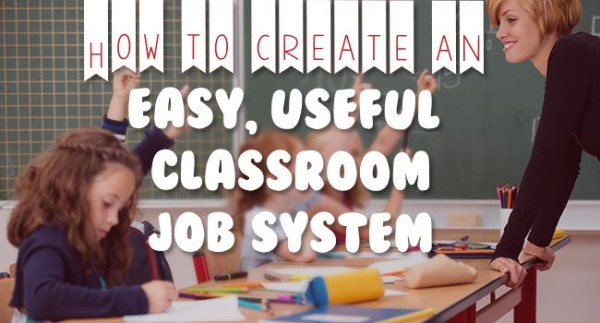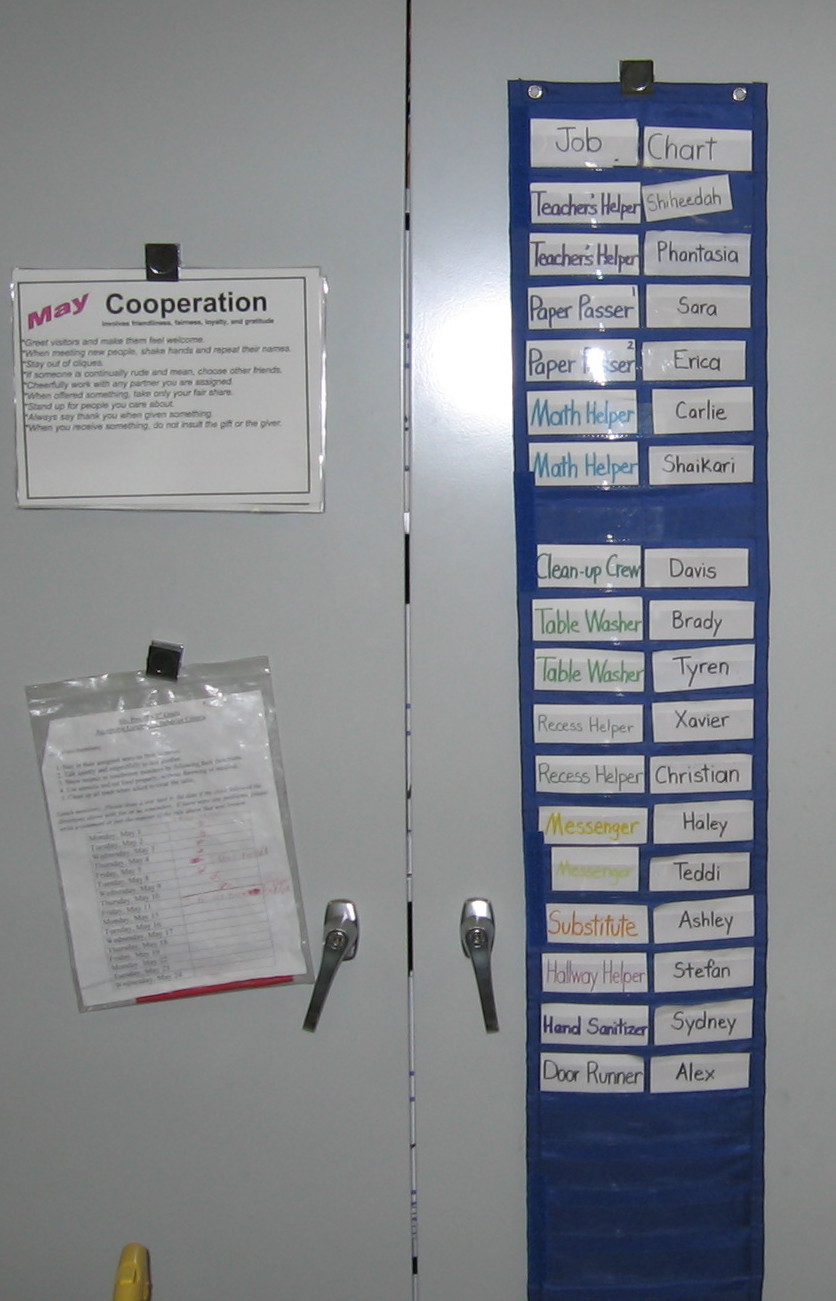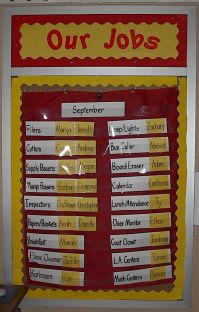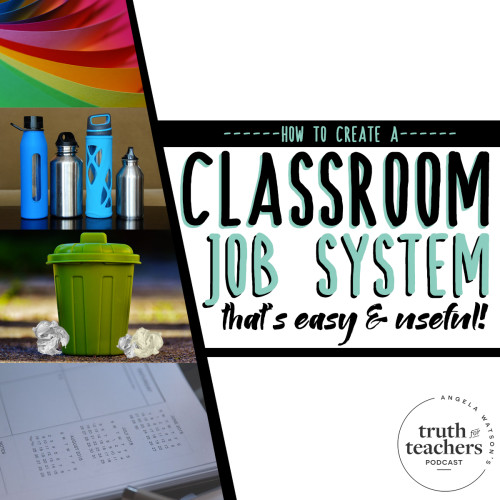When meaningful tasks are assigned to students, and kids understand and are capable of your expectations, classroom jobs become a fundamental part of your classroom. Your students can be a tremendous assistance to you! This page (which is excerpted from Chapter 12 “Student Responsibility and Organization” of The Cornerstone book) shows you how to make it happen.

Is it really necessary to have class jobs?
Personally, I’ve always felt I would be lost without my classroom job system! My kids do dozens of routine tasks for me, and complete them automatically. When I miss a day of work and have to call a substitute, I know that the classroom will be maintained because students are aware of their responsibilities and anxious to complete them.
Sometimes I hear from teachers who dislike having classroom jobs, and feel like they’re just a big hassle. Typically, these teachers are only assigning jobs because they want students to learn to be responsible for the classroom. However, that’s not the job system’s main function. Students learn responsibility everyday as they practice caring for their belongings and keeping their desk area well-organized and neat.
The primary purpose of classroom jobs is to transfer responsibility to students for keeping the classroom running smoothly, resulting in uninterrupted instruction. If your classroom job system is effective, you will never again have five kids waving their arms and shouting, “Ooh! Ooh! Can I do it?” because your answer will always be the same: “Are you the helper for that?”
Designing a genuinely useful classroom job system
1) Make a list of ALL your routine tasks.
Any regular classroom task which you want to be performed automatically without your direct supervision should be assigned. I usually add and delete jobs over the months as the needs in our classroom change. I like to have one job for each child in the class, partially so no one feels left out, but mostly because I have so many things that I need help with!
- Paper Passers 1,2
- Paper Collector
- Supply Passers 1,2
- Plant Waterer
- Attendance Taker
- Floor Monitor (makes sure the floor is clean at set points during the day)
- Door Holder (not necessary if you teach kids to hold the door for the person behind them)
- Line Leader (I don’t use this one or Line Ender because we have a set line order)
- Line Ender
- Desk Inspector (makes sure desks are clean)
- Windows/Blinds Monitor (opens and closes as needed)
- Media [TV, DVD, CD] Monitor (turns off and on, adjusts volume)
- Cutters 1,2 (cuts out laminating, etc. for you)
- Filers 1,2
- Breakfast Helper (if kids eat in the classroom: supervises clean-up)
- Trash Monitor
- Board Eraser
- Calendar Helper
- Pledge/Flag Helper
- Computer Helper (turns off/on; could also be in charge of trouble-shooting for kids)
- Centers Monitor
- Bulletin Board Helper (helps changes displays)
- Dictionary Helper (passes out/collects)
- Book Bin Helpers 1,2
- Lamp Monitor (turns off/on)
- Lights Monitor
- Door Monitor (makes sure it’s locked, lets visitors in when they knock)
- Lunch Count Helper
- Cubby/Coat Closet Monitor
- Sink Monitor (stands by sink when kids are lined up to wash hands)
- Soap Helper (gives each child one small half-pump of soap)
- Weather Helper
- Hall Monitor
- Token Helper (if you use the Token System)
- Errand Runner
- Drink Monitor
- Recess Helper (carries materials out to the playground)
- Homework Helper (makes sure kids have the right dittos/assignments copied)
There are a few considerations you may want to keep in mind as you select jobs. You may want to:
Choose ‘semi-permanent’ or ‘indefinite’ jobs which you want students to do for a longer period of time. For example, keeping my class library organized is a big job that only very mature, responsible kids can do, so I don’t put that in my regular rotation. I show kids my list of indefinite jobs and tell them I’m going to choose students who demonstrate specific qualities that are needed for each job.
Allow certain jobs to be done only by students who leave the classroom last at the end of the day. In addition to my regular job system, I give extra responsibilities to car riders (the students who are last to be dismissed). They straighten desks, change the calendar marker to the next day, erase the board, and so on. I work with the car riders to decide who will do each job, and they are responsible for completing them indefinitely (until there is a problem or they want to switch).
Assign some jobs to multiple students. I have two Table Washers, two Recess Equipment Helpers, and so on. I just list them as Helper 1 and Helper 2 on the job chart, and both are equally responsible.
Have the job of ‘Substitute’ who takes over for anyone who’s absent. If a helper is out of the room or otherwise engaged, I have my Substitute complete tasks as needed.
Have one or two students take the job of ‘Teacher’s Helper’ for those miscellaneous tasks that aren’t specifically covered on the job chart. This comes in handy when an unexpected situation arises, such as the need for passing out extra napkins during a class party. You won’t have to look around for kids who have been ‘good’ to help you out—just ask your Teacher’s Helpers.
2) Find a way to display your classroom job assignments


There are a million cute ways to do this, but I use a simple, functional, pocket chart. The most important thing is that your display is sturdy (since students will need to move their names around) and easily visible through-out the room (so that wherever you’re at, you can call on the people you need).
3) Decide how jobs will be assigned.
Some teachers have a rotation system so that every child gets to do every job an equal number of times. I like to allow children to choose their jobs so that I know things will get done properly. Most of my kids don’t want to refill the soap and paper towels in the bathroom, and if I assign that job to them, they won’t do it to the best of their ability. However, there are always a few kids in the room who love this task, and if I allow them to volunteer for it, I can be sure it will be done routinely and to my standards.
I used to have my students choose in order of how well they did the previous week/month’s job (those who did not need constant reminders were allowed to pick first—we discussed this as a class so they would understand my criteria and reasoning), or according to social skills grades on weekly evaluations (i.e. the most responsible students who followed class rules picked first). Both ways made sense to the children, but you could pick randomly if you prefer, and that method has worked well for some of my groups of children, too.
I typically put the name cards in the order I want them and have a student call the kids up to choose their jobs during Fun Friday or Monday’s Morning Work to save me time and minimize interruptions to instruction. Sometimes I’ll take the cards out of the pocket and have them lying on the table when students enter the classroom, listing ‘Choose a new job’ as one of the Morning Work tasks written on the board. Having kids pick jobs first thing in the morning also encourages them to be on time for school.
Students can choose a job they have already had, but not twice in a row (they will naturally keep track of this mentally for each other so you won’t have to remember—trust me). If there are no jobs left that a student wants, she can opt not to have a job and someone else can take two. (This only happened once, but handling the issue this way gives the kids a sense of control and empowerment.)
4) Determine how long students will keep their jobs.
I like for my kids to keep the same jobs for at least a week. With some groups of children, I switch every other week or even monthly. The longer the student holds a job, the more automatic it becomes, and the better they do it. Also, it’s easier for me to remember who has which job (in case it isn’t done, or the student is absent). Switching jobs daily can lead to confusion and poorly done tasks, because the children forget what their jobs are and how to do them properly. Remember, the primary purpose of classroom jobs is not to teach students responsibility (they learn that principle daily in taking care of their own belongings); the main function is to keep the classroom running smoothly so that instruction is not interrupted.
Introducing and maintaining the job system
Explaining the system to students on the first day of school is important, but it’s even more important to teach students how to do their jobs in whole-class modeling/practice sessions. The Cornerstone book and eBook explain how to do this as part of your introduction to routines and procedures. It even includes scripts that show you what to say during the whole-class modeling that teaches students how to do the jobs the way you need them done. You’ll also find our how to help students train each other to do the jobs.
Remember: You MUST use your helper system consistently!
If you have kids constantly asking if they can do something for you, you’re not being unremitting about using your classroom helpers. Any deviation from the agreement about who is doing what job will undermine your system. When you’re in a rush, it might be easier to just have the kid standing next to you pass out your papers, but it will disrupt the flow of the classroom. The child will wonder, Why did she ask me to do that? I’m the Hallway Monitor! Is there something wrong with the person who’s supposed to be passing out papers? Are we not doing classroom jobs anymore? And that’s not to mention the look of disappointment you’ll get from the actual Paper Passer who wants to know why somebody else is doing her job! If you want tasks to be completed automatically, don’t tamper with the system. Let it work for you.

Rearrange your system as often as needed
You can add, modify, or take out jobs anytime you feel doing so would help your classroom run more smoothly. I regularly make changes based on my needs and the abilities of my children. Don’t ever feel locked into doing something in a way that’s not working, just because you don’t want to ‘confuse’ the kids. Level with them by saying, “I don’t think this is working, because I’m noticing __ and __. So instead, I want to try __.” Seek the kids’ input and value their opinions.
Incorporating your students’ input is really valuable as you re-think your system. I once had a new student join the class and asked my kids to suggest another job for me to add to the job chart. Some of their ideas were tasks I would never have thought of, and they greatly improved the level of efficiency in our classroom! Keep kids involved in the process, and show them that’s it’s important to reflect on what’s working and what’s not in life, and make changes appropriately. This type of critical thinking will stay with children long after they leave your classroom.

Angela Watson
Founder and Writer
Sign up to get new Truth for Teachers articles in your inbox
Discussion
OR

Join our
community
of educators
If you are a teacher who is interested in contributing to the Truth for Teachers website, please click here for more information.
















I have been teaching 10 years, and have created a system of routines that have worked for me in the past. Our district recently increased our class size from 21 to 29. This increase has thrown a huge “wrench” in my system. I have been struggling with the change, but thanks to your valuable ideas and information I will be able to make adjustments. I look forward to reading other topics and ideas from your website.
Hi, Liliana, I’m so glad this information has been helpful to you! I went from teaching 18 kids to 27 kids from one school year to the next (and another time, from 17 to 23) so I know what’s it like to be unaccustomed to having a much larger class size. It sometimes feels like everything takes twice as long to complete, especially grading and parent conferences. It’s a huge adjustment, and I’m happy I’ve been able to make it a little easier for you. 🙂
I’m wondering where you purchased the blue narrow pocket charts–I’ve been looking but can’t seem to find any that are narrow such as these. Thanks
Hi, Mrs. May, I actually ‘inherited’ that chart from a teacher who left it behind when she transferred schools. However, it’s a simple daily schedule pocket chart, like this: http://www.amazon.com/exec/obidos/ASIN/0545114985/cornerstonewebsite-20. I think you’ll be able to find a really narrow one if you search for ‘schedule pocket chart’. 🙂
Hi Angela.
Love the website and I am totally going to order the book. I was just wondering if you have any suggestions (or websites) for substitute teachers regarding classroom management? (including setting rules, keeping students on task, etc). I sub at both elementary and high school levels, so suggestions for both scenarios would be very helpful.
Thanks
Crystal Musfelt
Hi, Crystal! I’ve gotten a lot of requests for substitute teacher hints. Unfortunately, I’ve never subbed, so I’ve been kind of reticent to post anything telling other people how to do it! I’m in the process of collecting some resources, though, and have already started a drafting a page. If you have sub resources you think should be shared there, let me know! 🙂
Crystal,
I have recently subbed in elementary/middle school settings. I do not know if you are familiar with responsive classroom/morning meeting. During this time, I take about 15 to tell the students about myself (I’m engaged, my pets, my wedding). I have built a repore with them. I then introduce my incentive system to them. For elementary settings, the students earn stars. When they earn three stars ( staying on task, being a great help, etc.), they earn a 10 minute “break”. This can include games- heads up 7 up, a structured game of their choice, or having a movement break- the cha cha slide, cupid shuffle, hokey pokey, chicken dance, etc. However, once the stars are earned, they can be taken away, and recess minutes can be taken away if necessary. I have only had to take away recess 2-3 times.
For middle school, I do a star wars challenge and tell the teacher. I ask in my notes if he or she can have that class earn an incentive.
I hope that helps!
-Ms. T
I’m a new teacher and the suggestions in here have been tremendously helpful. Wish I’d found this site in the beginning of the year!
Hi, Tasha! Thanks for taking the time to comment. Let me know if there is anything I can do to help out. 🙂
Hello, I have just came across your site today – wow. I can’t stop reading it. I like your tips and suggestions for classroom styles and management. I have just quailified as an EYP Level 2 – however, I plan to contine my training upto Level 4 – as I would love to open my own Shopping Centre Creche near where I live. I would love to try and use your style of managment with children. I will go now, as I want to continue reading your site. I would love to know how, yu control a large number of childcren in classroom whilst (sitting on carpet) it is Hard to get all their attention – “Without Raising your voice” which is not allowed now, in schools (certainly in in North East of England, were I am from) As I feel somedays – it is harder to control all childern at same time – (however) the teacher in the classroom does, seem to manage. But, I know you can raise the TONE in your voice to receive children’s attention – Does, it all go on what you say?
So sorry my comment is long- I love typing.
THANK YOU